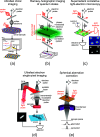Roadmap for Quantum Nanophotonics with Free Electrons
- PMID: 40978571
- PMCID: PMC12447556
- DOI: 10.1021/acsphotonics.5c00585
Roadmap for Quantum Nanophotonics with Free Electrons
Abstract
Over the past century, continuous advancements in electron microscopy have enabled the synthesis, control, and characterization of high-quality free-electron beams. These probes carry an evanescent electromagnetic field that can drive localized excitations and provide high-resolution information on material structures and their optical responses, currently reaching the sub-Å and few-meV regime. Moreover, combining free electrons with pulsed light sources in ultrafast electron microscopy adds temporal resolution in the subfemtosecond range while offering enhanced control of the electron wave function. Beyond their exceptional capabilities for time-resolved spectromicroscopy, free electrons are emerging as powerful tools in quantum nanophotonics, on par with photons in their ability to carry and transfer quantum information, create entanglement within and with a specimen, and reveal previously inaccessible details on nanoscale quantum phenomena. This Roadmap outlines the current state of this rapidly evolving field, highlights key challenges and opportunities, and discusses future directions through a collection of topical sections prepared by leading experts.
Keywords: electron microscopy; electron−light interactions; materials science; quantum physics; ultrafast phenomena.
© 2025 The Authors. Published by American Chemical Society.
Figures





















References
-
- Spence, J. C. H. High-Resolution Electron Microscopy; Oxford University Press: Oxford, 2013.
-
- Dellby N., Lovejoy T., Corbin G., Johnson N., Hayner R., Hoffman M., Hrncrik P., Plotkin-Swing B., Taylor D., Krivanek O.. Ultra-High Energy Resolution EELS. Microsc. Microanal. 2020;26:1804–1805. doi: 10.1017/S1431927620019406. - DOI
-
- Zhu D., Robert A., Henighan T., Lemke H. T., Chollet M., Glownia J. M., Reis D. A., Trigo M.. Phonon Spectroscopy with Sub-MeV Resolution by Femtosecond x-Ray Diffuse Scattering. Phys. Rev. B. 2015;92:054303. doi: 10.1103/PhysRevB.92.054303. - DOI
-
- Egerton, R. F. Electron Energy-Loss Spectroscopy in the Electron Microscope; Plenum Press, 1996.
-
- García de Abajo F. J.. Optical Excitations in Electron Microscopy. Rev. Mod. Phys. 2010;82:209–275. doi: 10.1103/RevModPhys.82.209. - DOI
Publication types
LinkOut - more resources
Full Text Sources
Miscellaneous
